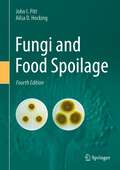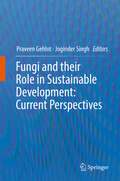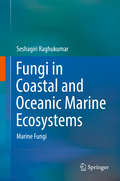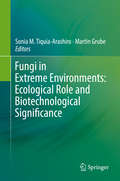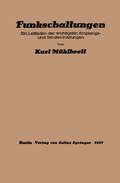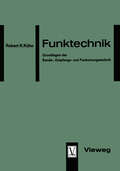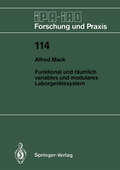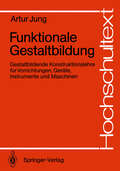- Table View
- List View
Fungi and Food Spoilage
by John I. Pitt A.D. HockingThis book is designed as a laboratory guide for the food microbiologist, to assist in the isolation and identification of common food-borne fungi. We emphasise the fungi which cause food spoilage, but also devote space to the fungi commonly encountered in foods at harvest, and in the food factory. As far as possible, we have kept the text simple, although the need for clarity in the descriptions has necessitated the use of some specialised mycological terms. The identification keys have been designed for use by microbiologists with little or no prior knowledge of mycology. For identification to genus level, they are based primarily on the cultural and physiological characteristics of fungi grown under a standardised set of conditions. The microscopic features of the various fungi become more important when identifying isolates at the species level. Nearly all of the species treated have been illustrated with colony photographs, together with photomicrographs or line drawings. The photomicrographs were taken using a Zeiss WL microscope fitted with Nomarski interference contrast optics. We are indebted to Mr W. Rushton and Ms L. Burton, who printed the many hundreds of photographs used to make up the figures in this book. We also wish to express out appreciation to Dr D.L. Hawksworth, Dr A.H.S.
Fungi and Food Spoilage
by John I. Pitt Ailsa D. HockingIn contrast to the second edition, the third edition of ‘‘Fungi and Food Spoilage’’ is evolutionary rather than revolutionary. The second edition was intended to cover almost all of the species likely to be encountered in mainstream food supplies, and only a few additional species have been included in this new edition. The third edition represents primarily an updating – of taxonomy, physiology, mycotoxin production and ecology. Changes in taxonomy reflect the impact that molecular methods have had on our understanding of classification but, it must be said, have not radically altered the overall picture. The improvements in the understanding of the physiology of food spoilage fungi have been relatively small, reflecting perhaps the lack of emphasis on physiology in modern mic- biological science. Much remains to be understood about the specificity of particular fungi for particular substrates, of the influence of water activity on the growth of many of the species treated, and even on such basic parameters as cardinal temperatures for growth and the influence of pH and preservatives. Since 1997, a great deal has been learnt about the specificity of mycotoxin production and in which commodities and products-specific mycotoxins are likely to occur. Changes in our understanding of the ecology of the included species are also in most cases evolutionary. A great number of papers have been published on the ecology of foodborne fungi in the past few years, but with few exceptions the basic ecology of the included species remains.
Fungi and Food Spoilage
by John I. Pitt Ailsa D. HockingThe first three editions of Fungi and Food Spoilage established, then consolidated, a reputation as the leading book on foodborne fungi. It details media and methods for isolation and identification, descriptions of species, and information on their physiology, ecology and mycotoxin formation. It is an invaluable reference for food microbiologists investigating fungal food spoilage problems, both in field crops and processed foods, and the likelihood of mycotoxin production in either.The Fourth Edition incorporates major differences from the Third: multiple changes in nomenclature due to changes in the International Code of Nomenclature for algae, fungi and plants; many taxonomic changes due to improvements in, and more widespread application of, molecular methods in taxonomy; the introduction of colour colony photographs where appropriate; and a new chapter on mycotoxins.The introductory chapters of the book deal with the ecology of food spoilage, and provide an overview of how food processing, packaging and storage parameters influence fungal growth. A subsequent chapter overviews the fundamentals of naming and classifying fungi. Morphological methods and media suitable for low cost and effective isolation, enumeration and identification of foodborne fungi are provided, together with many more specialised media and techniques. The major part of the book provides keys, descriptions and illustrations of all yeasts and filamentous fungi commonly encountered in foods. Other known characteristics of the species, including physiology and ecology are included. Chapters on the types and species of fungi likely to be found in fresh, harvested and variously processed foods are followed by a new chapter on mycotoxins, both major and minor, their sources, both fungal and food, and their implications for human health.The broad and practical nature of the coverage will appeal to microbiologists, mycologists and biotechnologists in the food industry, as well scientists in academic, research and public health institutions.Drs Pitt and Hocking worked for CSIRO Food for more than 100 years combined. Both are now retired from CSIRO: Dr Pitt continues to work part time with Microbial Screening Technologies, a biodiscovery company.
Fungi and Lignocellulosic Biomass
by Christian P. KubicekHarnessing fungi’s enzymatic ability to break down lignocellulolytic biomass to produce ethanol more efficiently and cost-effectively has become a significant research and industrial interest. Fungi and Lignocellulosic Biomass provides readers with a broad range of information on the uses and untapped potential of fungi in the production of bio-based fuels. With information on the molecular biological and genomic aspects of fungal degradation of plant cell walls to the industrial production and application of key fungal enzymes, chapters in the book cover topics such as enzymology of cellulose, hemicelluloses, and lignin degradation. Edited by a leading researcher in the field, Fungi and Lignocellulosic Biomass will be a valuable tool in advancing the development and production of biofuels and a comprehensive resource for fungal biologists, enzymologists, protein chemists, biofuels chemical engineers, and other research and industry professionals in the field of biomass research.
Fungi and Lignocellulosic Biomass
by Christian P. KubicekHarnessing fungi’s enzymatic ability to break down lignocellulolytic biomass to produce ethanol more efficiently and cost-effectively has become a significant research and industrial interest. Fungi and Lignocellulosic Biomass provides readers with a broad range of information on the uses and untapped potential of fungi in the production of bio-based fuels. With information on the molecular biological and genomic aspects of fungal degradation of plant cell walls to the industrial production and application of key fungal enzymes, chapters in the book cover topics such as enzymology of cellulose, hemicelluloses, and lignin degradation. Edited by a leading researcher in the field, Fungi and Lignocellulosic Biomass will be a valuable tool in advancing the development and production of biofuels and a comprehensive resource for fungal biologists, enzymologists, protein chemists, biofuels chemical engineers, and other research and industry professionals in the field of biomass research.
Fungi and their Role in Sustainable Development: Current Perspectives
by Praveen Gehlot Joginder SinghThis book illustrates the multiple roles of fungi in everyday life. Fungi are the large group of organisms with tremendous diversity and economic importance. Their ability to produce commercially efficient useful products makes them the vulnerable sustainable tool for the future generation. This book describes a systems approach and provides a means to share the latest developments and advances about the benefits of fungi including their wide application, traditional uses, modern practices, along with designing of strategies to harness their potential. The chapters are organized with data, providing information related to different sustainable aspects of fungi in agriculture, its cultivation and conservation strategies, industrial and environmental utilization, advanced bioconversion technologies and modern biotechnological interventions. Updated information and current opinion related to its application for sustainable agriculture, environment, and industries as futuristic tools have been presented and discussed in different chapters. The book also elucidates a comprehensive yet a representative description of the challenges associated with the sustained application of fungi to achieve the goals of sustainability.
Fungi as Bioremediators (Soil Biology #32)
by Ebrahim Mohammadi Goltapeh, Younes Rezaee Danesh and Ajit VarmaBiological remediation methods have been successfully used to treat polluted soils. While bacteria have produced good results in bioremediation for quite some time now, the use of fungi to decontaminate soils has only recently been established. This volume of Soil Biology discusses the potentials of filamentous fungi in bioremediation. Fungi suitable for degradation, as well as genetically modified organisms, their biochemistry, enzymology, and practical applications are described. Chapters include topics such as pesticide removal, fungal wood decay processes, remediation of soils contaminated with heavy and radioactive metals, of paper and cardboard industrial wastes, and of petroleum pollutants.
Fungi in Coastal and Oceanic Marine Ecosystems: Marine Fungi
by Seshagiri RaghukumarThis book offers an ecosystem-oriented overview of the diversity, ecological role, and biotechnological applications of marine fungi as well as an in-depth introduction to the marine environment, fungal classification, and ecological principles. It also presents the latest research findings on coastal marine and oceanic ecosystems, such as mangrove, seagrass, salt marsh, algal, coral reef and benthic ecosystems. Focusing on the diversity of fungi as well as their role as symbionts, parasites and saprotrophs, the book also discusses the physiology and biotechnological applications of fungi and highlights topics of future interest. Intended for students and researchers in marine biology and microbiology, it includes detailed descriptions, illustrations, figures, tables, and exhaustive literature citations. A detailed chapter on methods used to study marine fungi, their classification and ecological principles is of particular interest to newcomers in the field.
Fungi in Extreme Environments: Ecological Role and Biotechnological Significance
by Sonia M. Tiquia–Arashiro Martin GrubeOver the last decades, scientists have been intrigued by the fascinating organisms that inhabit extreme environments. These organisms, known as extremophiles, thrive in habitats which for other terrestrial life-forms are intolerably hostile or even lethal. Based on such technological advances, the study of extremophiles has provided, over the last few years, ground-breaking discoveries that challenge the paradigms of modern biology. In the new bioeconomy, fungi in general, play a very important role in addressing major global challenges, being instrumental for improved resource efficiency, making renewable substitutes for products from fossil resources, upgrading waste streams to valuable food and feed ingredients, counteracting life-style diseases and antibiotic resistance through strengthening the gut biota, making crop plants more robust to survive climate change conditions, and functioning as host organisms for production of new biological drugs. This range of new uses of fungi all stand on the shoulders of the efforts of mycologists over generations. The book is organized in five parts: (I) Biodiversity, Ecology, Genetics and Physiology of Extremophilic Fungi, (II) Biosynthesis of Novel Biomolecules and Extremozymes (III) Bioenergy and Biofuel synthesis, and (IV) Wastewater and biosolids treatment, and (V) Bioremediation.
Fungi in Fuel Biotechnology (Fungal Biology)
by Gholamreza Salehi Jouzani Meisam Tabatabaei Mortaza AghbashloDue to the huge quantity and diverse nature of their metabolic pathways, fungi have great potential to be used for the production of different biofuels such as bioethanol, biobutanol, and biodiesel. This book presents recent advances, as well as challenges and promises, of fungal applications in biofuel production, subsequently discussing plant pathogenic fungi for bioethanol and biodiesel production, including their mechanisms of action. Additionally, this book reviews biofuel production using plant endophytic fungi, wood-rotting fungi, fungal biocontrol agents, and gut fungi, and it investigates highly efficient fungi for biofuel production and process design in fungal-based biofuel production systems. Finally, life cycle assessment of fungal-based biofuel production systems are discussed in this volume.
Fungi of Antarctica: Diversity, Ecology and Biotechnological Applications
by Luiz Henrique RosaThis book focuses on the fungi found in one of the most pristine regions on Earth: Antarctica. It discusses the fungal occurrence in all substrates of the region, including soil, seawater, lake and marine sediments, rocks, ice, and snow. It also addresses the impact of climate changes on these organisms, the genomic techniques developed to study them, and how a number of compounds, such as antibiotics and enzymes, produced by the Antarctic fungi can be used in medicine, agriculture and the chemical industry.
Fungicide Resistance in Plant Pathogens: Principles and a Guide to Practical Management
by Hideo Ishii Derek William HollomonThis volume offers a comprehensive coverage of the general principles and recent advances in fungicide resistance. It describes the development, mechanisms, monitoring, and management of resistance and covers the most important group of fungicides that have caused resistance on various crops. An historical review of fungicide resistance over the past 40 years sets the scene for up-to-date basic information on mode of action, as well as the genetics, mechanisms, and evolution of resistance. Monitoring for resistance, including the latest developments in molecular diagnostics, moves readers into the practical aspects of resistance management, which is dealt with through a series of case studies outlining fungicide-use strategies on several key crops. The chapters reflect the experience of authors internationally recognised for their significant contributions to fungicide resistance research. The majority of crop diseases are caused by fungal pathogens, and disease control relies heavily on chemically synthesized fungicides. However, modern fungicides often encounter the problem of resistance development in target pathogens. Thus pathogen resistance to fungicides is an important factor that causes loss of yield and quality of crops. It often threatens biosecurity through the decrease of fungicide efficacy in the fields. To manage fungicide resistance successfully will require the promotion of integrated disease management, involving not just chemical fungicides, but also host plant resistance, agronomic factors, and reliable biological control agents where these are available. Well referenced throughout, the book offers a comprehensive account of resistance, which will be useful as a source of material for lecturers and for both industrial and academic scientists involved in fungicide resistance research. It is also a valuable sourcebook for students.
Fungicides in Practice
by Richard P. Oliver Professor Janna L BeckermanThis is an up-to-date guide on the science and practice of disease control based on fungicides in horticulture and broad acre agriculture. It describes how conventional, organic and biological fungicides are discovered, how they work and how resistance evolves. Chapters on formulation, mode of action, mobility and application inform decisions about which fungicides to use, when to use them, and how to rotate (or tank-mix) them, to manage both plant disease and fungicide resistance. A chapter on experimental design of fungicide trials aids practitioners in designing their own trials to evaluate how effective products are for their plant disease problem. Based on the successful 2014 book of Fungicides in Crop Protection this edition has four entirely new chapters, and extensive updates to the other nine chapters. The contents include: · Fungicide markets, discovery and performance. · Modes of action and spectrum. · Biological crop protection, and organic cultivation. · Fungicide formulation, mobility and application. · Experimental design of fungicide trials and their analysis. · Fungicide resistance. · Legislation and regulation. Written for crop protection professionals and scientists, growers, agronomists and consultants, the book is also suitable for students of agriculture and agronomy.
Funkenerosive Bearbeitung: Untersuchungen von Einflußgrößen bei der funkenerosiven Senkbearbeitung (Forschungsberichte des Landes Nordrhein-Westfalen #1145)
by Herwart OpitzFunkenerosive Bearbeitung von Hartmetall (Forschungsberichte des Landes Nordrhein-Westfalen #2406)
by Wilfried KönigFunkortung und Funknavigation: Eine Einführung in die Grundlagen, Verfahren und Anwendungen (Nachrichtentechnik)
by Erwin LertesIn diesem Lehrbuch für Studierende der Nachrichtentechnik, für Systemplaner, Entwicklungs-, Erprobungs- und Wartungsingenieure sowie für Ingenieure fernmeldetechnischer Dienste werden folgende Themen behandelt: Funkwellen, Funkpeilung, Radar, Funkfeuer der Luftfahrt, Landesysteme (ILS/MLS), Hyperbelortungssysteme, Satellitengestützte Funkortung (GPS), VLF-Empfang in Seewasser (U-Boot-Navigation).
Funkschaltungen: Ein Leitfaden der wichtigsten Empfangs- und Sendeschaltungen
by Karl MühlbrettDieser Buchtitel ist Teil des Digitalisierungsprojekts Springer Book Archives mit Publikationen, die seit den Anfängen des Verlags von 1842 erschienen sind. Der Verlag stellt mit diesem Archiv Quellen für die historische wie auch die disziplingeschichtliche Forschung zur Verfügung, die jeweils im historischen Kontext betrachtet werden müssen. Dieser Titel erschien in der Zeit vor 1945 und wird daher in seiner zeittypischen politisch-ideologischen Ausrichtung vom Verlag nicht beworben.
Funktechnik: Grundlagen der Sende-, Empfangs- und Funkortungstechnik
by Robert Richard KühnDas vorliegende Buch wurde für die Ausbildung des Funkpersonals und der Funk techniker in der kommerziellen Technik und in anderen Fachgebieten außerhalb der Unterhaltungstechnik geschrieben. Besonderer Wert wurde auf die Erarbeitung der Grundlagen gelegt, auf die heute weniger denn je verzichtet werden kann. Es wird jedoch vorausgesetzt, daß der Leser mit den einfachen Grundgesetzen der Elektrotechnik bereits vertraut ist. Unter weitgehendem Verzicht auf mathematische Hilfsmittel werden alle z. Z. in der Funktechnik angewendeten Prinzipien erläutert, sofern deren Kennmis für die Praxis nützlich erschien. Unter anderem wird gezeigt, daß sich die Vielfalt der physikalischen Vorgänge auf verhälmismäßig wenig grundsätzliche Erscheinungen zurückführen läßt, die überall in der Elektrotechnik zu finden sind. Neben der Vermittlung der Grundlagen werden viele praktische Hinweise fur das Arbeiten mit Funkanlagen gegeben. Diese Teile des Buches werden auch von dem bereits in der Praxis stehenden Funk personal mit Gewinn gelesen werden, zumal die neuesten Erkenntnisse und Er fahrungen ausgewertet wurden. In einer weiteren Veröffentlichung sollen gerätekundliehe Themen behandelt werden.
Funktechnische Aufgaben und Zahlenbeispiele (Bibliothek des Radio Amateurs (geschlossen) #21)
by Karl MühlbrettDieser Buchtitel ist Teil des Digitalisierungsprojekts Springer Book Archives mit Publikationen, die seit den Anfängen des Verlags von 1842 erschienen sind. Der Verlag stellt mit diesem Archiv Quellen für die historische wie auch die disziplingeschichtliche Forschung zur Verfügung, die jeweils im historischen Kontext betrachtet werden müssen. Dieser Titel erschien in der Zeit vor 1945 und wird daher in seiner zeittypischen politisch-ideologischen Ausrichtung vom Verlag nicht beworben.
Funktional und räumlich variables und modulares Laborgerätesystem (IPA-IAO - Forschung und Praxis #114)
by Alfred MackFunktionalanalysis (Mathematik für Ingenieure und Naturwissenschaftler, Ökonomen und Landwirte)
by Alfred Göpfert Thomas RiedrichFunktionalanalysis (Springer-Lehrbuch)
by Dirk WernerJetzt in 6., korrigierter Auflage – leicht lesbar, gründlich. "Bei dem Lehrbuch handelt es sich um einen sehr schönen, gut geschriebenen einführenden Band ... Das Buch deckt den gesamten 'klassischen' Stoff einer zweisemestrigen Funktionsanalysis-Vorlesung ab, bietet aber mehr: Es setzt Akzente, wie man sie bei anderen Einführungen bisher nicht gefunden hat ... Die Stärken des Buches liegen in den vielen durchgerechneten Beispielen, Anwendungen, interessanten Übungen ... Kapitelzusammenfassungen und Ausblicken ..." (in: Zentralblatt für Mathematik und ihre Grenzgebiete). Plus: historische und weiterführende Bemerkungen, über 200 Aufgaben.
Funktionale Gestaltbildung: Gestaltbildende Konstruktionslehre für Vorrichtungen, Geräte, Instrumente und Maschinen (Hochschultext)
by Artur JungDieses Buch behandelt den konstruktiven Entwurfsvorgang, wie er sich in der Praxis in vielen Fällen darstellt, in einem vernetzten Ablaufmodell (Drei-Ebenen-Modell). Damit ergänzt es die heute üblichen Ablaufpläne und versucht, den schwierigen Vorgang der Gestaltbildung technischer Produkte aus Vorstellungen über ihre Funktionen erfaßbar zu machen. Zur Synthese und Analyse des Konstruktionsprozesses werden die Begriffe "Geometrie-Funktionsprinzip" und "Gestaltfunktion" eingeführt und an Beispielen erläutert. Das besondere Anliegen des Autors ist dabei, die geometrisch-funktionale Denkweise, die ein Konstrukteur meist unbewußt praktiziert, für den Studierenden didaktisch aufzubereiten, übergreifende Aspekte sichtbar und für den Gestaltungsvorgang nutzbar zu machen. Die behandelten Beispiele reichen von einfachen Vorrichtungen über Präzisionsinstrumente bis hin zu den genau arbeitenden Maschinen der Feinwerktechnik.


